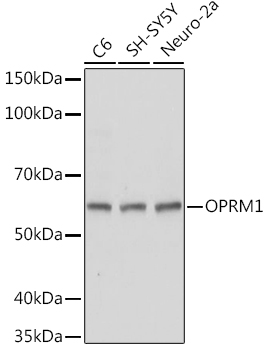Cell Biology Antibodies 14
Anti-OPRM1 Antibody (CAB16939)
- SKU:
- CAB16939
- Product Type:
- Antibody
- Reactivity:
- Human
- Reactivity:
- Mouse
- Reactivity:
- Rat
- Host Species:
- Rabbit
- Isotype:
- IgG
- Antibody Type:
- Polyclonal Antibody
- Research Area:
- Cell Biology
Description
| Antibody Name: | Anti-OPRM1 Antibody |
| Antibody SKU: | CAB16939 |
| Antibody Size: | 20uL, 50uL, 100uL |
| Application: | WB IHC IF |
| Reactivity: | Human, Mouse, Rat |
| Host Species: | Rabbit |
| Immunogen: | A synthetic peptide corresponding to a sequence within amino acids 300 to the C-terminus of human OPRM1 (NP_000905.3). |
| Application: | WB IHC IF |
| Recommended Dilution: | WB 1:500 - 1:2000 IHC 1:50 - 1:200 IF 1:50 - 1:200 |
| Reactivity: | Human, Mouse, Rat |
| Positive Samples: |
| Immunogen: | A synthetic peptide corresponding to a sequence within amino acids 300 to the C-terminus of human OPRM1 (NP_000905.3). |
| Purification Method: | Affinity purification |
| Storage Buffer: | Store at -20°C. Avoid freeze / thaw cycles. Buffer: PBS with 0.02% sodium azide, 50% glycerol, pH7.3. |
| Isotype: | IgG |
| Sequence: | IYVI IKAL VTIP ETTF QTVS WHFC IALG YTNS CLNP VLYA FLDE NFKR CFRE FCIP TSSN IEQQ NSTR IRQN TRDH PSTA NTVD RTNH QLEN LEAE TAPL P |
| Gene ID: | 4988 |
| Uniprot: | P35372 |
| Cellular Location: | Cell membrane, Cytoplasm, Multi-pass membrane protein |
| Calculated MW: | 10-20kDa/33-55kDa |
| Observed MW: | Refer to figures |
| Synonyms: | OPRM1, LMOR, M-OR-1, MOP, MOR, MOR1, OPRM |
| Background: | This gene encodes one of at least three opioid receptors in humans; the mu opioid receptor (MOR). The MOR is the principal target of endogenous opioid peptides and opioid analgesic agents such as beta-endorphin and enkephalins. The MOR also has an important role in dependence to other drugs of abuse, such as nicotine, cocaine, and alcohol via its modulation of the dopamine system. The NM_001008503.2:c.118A>G allele has been associated with opioid and alcohol addiction and variations in pain sensitivity but evidence for it having a causal role is conflicting. Multiple transcript variants encoding different isoforms have been found for this gene. Though the canonical MOR belongs to the superfamily of 7-transmembrane-spanning G-protein-coupled receptors some isoforms of this gene have only 6 transmembrane domains. |
| UniProt Protein Function: | MOR-1: a Gi-protein-coupled receptor for beta-endorphin, morphine and other opiates. Inhibits neurotransmitter release by reducing calcium ion currents and increasing potassium ion conductance. Ligand-binding inactivates adenylyl cyclase, and activates a variety of G-beta-gamma-dependent pathways including the MAPK and the PI3K/Akt cascades. Two splice-variant isoforms have been described. |
| UniProt Protein Details: | Protein type:GPCR, family 1; Membrane protein, multi-pass; Receptor, GPCR; Membrane protein, integral Chromosomal Location of Human Ortholog: 6q24-q25 Cellular Component: dendrite cytoplasm; Golgi apparatus; neuron projection; focal adhesion; endoplasmic reticulum; integral to plasma membrane; plasma membrane; perikaryon; sarcolemma; lipid raft Molecular Function:G-protein coupled receptor activity; voltage-gated calcium channel activity; neuropeptide binding; protein domain specific binding; protein binding; G-protein alpha-subunit binding; G-protein beta-subunit binding; filamin binding; beta-endorphin receptor activity Biological Process: response to food; positive regulation of neurogenesis; positive regulation of nitric oxide biosynthetic process; wound healing; negative regulation of nitric oxide biosynthetic process; cellular response to stress; negative regulation of adenylate cyclase activity; locomotory behavior; response to lipopolysaccharide; behavioral response to ethanol; sensory perception of pain; response to cocaine; G-protein signaling, coupled to cyclic nucleotide second messenger; negative regulation of cell proliferation; synaptic transmission; elevation of cytosolic calcium ion concentration; neuropeptide signaling pathway; reduction of cytosolic calcium ion concentration; positive regulation of appetite; sensory perception; opioid receptor, adenylate cyclase inhibiting pathway; G-protein signaling, coupled to IP3 second messenger (phospholipase C activating); regulation of sensory perception of pain; regulation of excitatory postsynaptic membrane potential; dopamine receptor, adenylate cyclase activating pathway; acute inflammatory response to antigenic stimulus Disease: Epilepsy, Idiopathic Generalized |
| NCBI Summary: | This gene encodes one of at least three opioid receptors in humans; the mu opioid receptor (MOR). The MOR is the principal target of endogenous opioid peptides and opioid analgesic agents such as beta-endorphin and enkephalins. The MOR also has an important role in dependence to other drugs of abuse, such as nicotine, cocaine, and alcohol via its modulation of the dopamine system. The NM_001008503.2:c.118A>G allele has been associated with opioid and alcohol addiction and variations in pain sensitivity but evidence for it having a causal role is conflicting. Multiple transcript variants encoding different isoforms have been found for this gene. Though the canonical MOR belongs to the superfamily of 7-transmembrane-spanning G-protein-coupled receptors some isoforms of this gene have only 6 transmembrane domains. [provided by RefSeq, Oct 2013] |
| UniProt Code: | P35372 |
| NCBI GenInfo Identifier: | 2851402 |
| NCBI Gene ID: | 4988 |
| NCBI Accession: | P35372.2 |
| UniProt Secondary Accession: | P35372,Q12930, Q4VWM1, Q4VWM2, B0FXJ1, B2R9S7, B8Q1L7 B8Q1L8, B8Q1L9, E7EWZ3, G8XRH6, G8XRH8, |
| UniProt Related Accession: | P35372 |
| Molecular Weight: | 20,188 Da |
| NCBI Full Name: | Mu-type opioid receptor |
| NCBI Synonym Full Names: | opioid receptor, mu 1 |
| NCBI Official Symbol: | OPRM1 |
| NCBI Official Synonym Symbols: | MOP; MOR; LMOR; MOR1; OPRM; M-OR-1 |
| NCBI Protein Information: | mu-type opioid receptor; mu opiate receptor; mu opioid receptor hMOR-1a |
| UniProt Protein Name: | Mu-type opioid receptor |
| UniProt Synonym Protein Names: | Mu opiate receptor; Mu opioid receptor; MOP; hMOP |
| Protein Family: | Mu-type opioid receptor |
| UniProt Gene Name: | OPRM1 |
| UniProt Entry Name: | OPRM_HUMAN |







